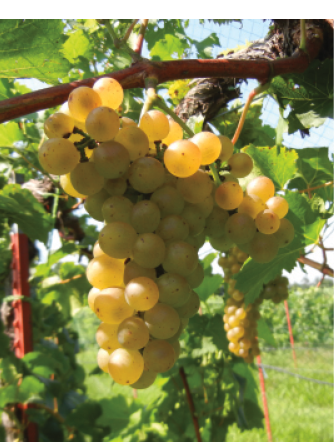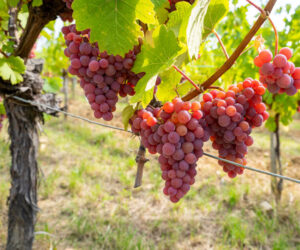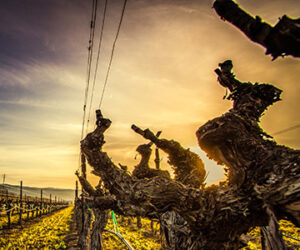 Some years back I was talking to a couple of friends from Missouri and they started talking about one of their favorite wines. They like and appreciate good wine, but they weren’t really wine people, meaning that wine was not their alcoholic beverage of choice. Rather, they were fonder of beer, so I took their pronunciation of the grape variety to be a case of mistaken identity and perhaps the intoxicating effects of the beers we were downing at the time. This was in the mid-1990s and Chardonnay was a rising star in the wine world with its green apple and buttery flavors, combined with too much time it often spent in the barrel. This was actually my mistake, because it was not Chardonnay that they were talking about, it was indeed Chardonel, an interspecific hybrid grape that was developed by researchers at the New York State Agricultural Experiment Station at Cornell University in Geneva, New York.
Some years back I was talking to a couple of friends from Missouri and they started talking about one of their favorite wines. They like and appreciate good wine, but they weren’t really wine people, meaning that wine was not their alcoholic beverage of choice. Rather, they were fonder of beer, so I took their pronunciation of the grape variety to be a case of mistaken identity and perhaps the intoxicating effects of the beers we were downing at the time. This was in the mid-1990s and Chardonnay was a rising star in the wine world with its green apple and buttery flavors, combined with too much time it often spent in the barrel. This was actually my mistake, because it was not Chardonnay that they were talking about, it was indeed Chardonel, an interspecific hybrid grape that was developed by researchers at the New York State Agricultural Experiment Station at Cornell University in Geneva, New York.
Chardonel is a white grape and, as the name implies, has Chardonnay as one of its parents. Chardonnay, the noblest of white grapes in Burgundy, has been around for centuries. The other parent is Seyval Blanc, a relatively new French hybrid, originally released in 1921 in Saint Vallier, Drôme, France, where it was known as Seyve-Villard. The original name coming from its creators Bertille Seyve and his son-in-law Villard. Seyval Blanc is a cross of French hybrids (Vitis rupestris x Vitis licencumii), so its actual vinifera percentages would be difficult to track. Therefore we can only assume that Chardonel is at least 50% Vitis vinifera.
The original Chardonel cross was made in 1953, and the first wines were made from it in 1966. The vine is classified as vigorous with large clusters. In the initial field trials, cluster weight averaged about half a pound (0.23 kg). The grapes take on an amber color and retain their acidity through ripening. According to the release statement for it, Chardonel “can produce a high quality wine with varietal character.” Further into the release, it described the wines as “pleasant and delicate with light fruitiness. In some years, the wine is slightly grassy. The wine has good body and very little of the flavor characteristics of interspecific hybrid grapes.” In 1990, Chardonel was finally released to the public.
Field trials were conducted at Cornell, Michigan State University, University of Arkansas, and California at Fresno State University. The variety was found to be resistant to phylloxera when grown on its own roots, showing moderate to high vigor rates. It was also found to be resistant to powdery mildew and Botrytis. This is generally viewed as a trifecta for varieties when it comes to growing grapes, especially in California where at the time of the trials, the variety was proposed to be a key component in reducing chemical use in vineyards. Interestingly the concept never caught on. Today there is not enough reportable acreage in California to list on the annual report prepared by the United States Department of Agriculture. In addition to disease-resistance and also of notable importance was its cold hardiness, slightly more than Seyval Blanc and significantly more than Chardonnay, which has made it popular in the lower Midwest, Finger Lakes of New York, and Virginia.
The wines of Chardonel are described to be very similar to its parent, Chardonnay, when grown in similar growing conditions. Chardonel is a far better wine than many California Chardonnays due to the potentially 2–3 percent differences in alcohol concentrations. In the field trials, the Brix range at harvest was 17–21 °Brix. Typical Chardonnay harvests are 23 °Brix and above.
It can be made into many different styles, dry to sweet, either aged in stainless steel or oak barrels. Being such a versatile grape, the winemaker has several choices with respect to styles. The first choice is selecting your harvest date. Chardonel is a late-ripening variety and in the aforementioned field studies, ripened between October 1 and October 15. In some regions, this gets close to the first frosts of the season. So the necessity of the harvest may be dictated by the weather. The grape tends to retain its acidity, therefore an early harvest would favor making Chardonel into a sparkling wine. This is not that common so consider yourself a pioneer if you so choose to go this route.
Pressing the grapes depends on what style you are making it into. A sparkling style almost certainly should be whole cluster pressed. Whole cluster pressing can be problematic for home winemakers, as most vertical basket presses will not fracture the berries. Bladder presses that use either water or air pressure to inflate the bladder and press to the outside work better for this purpose. Run the press up to 1–1.5 bar for the initial one or two press cycles. This should fracture the berries sufficiently and then follow this up with many short, light presses. Retract the bladder once the juice flow slows down and repeat for as many cycles it takes to completely de-juice. For later press cycles, look for color changes in the juice that would indicate excessive skin contact or oxidation. Add your sulfur dioxide by “metering” it into the press sump. Metering your sulfur dioxide involves adding small volumes at a time, being careful to add just enough to prevent browning. Typically, adding 3 milliliters per gallon (3.8 L) of 10 percent potassium metabilsulfite equates to just under a 50 mg/L addition. To make Chardonel into a dry or semi-sweet style, de-stem and crush the berries followed by a light pressing. Again, meter your sulfur dioxide additions to prevent browning of the juice.
Selecting yeast that favors the formation of aromatics is another area where winemakers have options. There are many yeast companies out there so the choice is yours. With so many to choose from it is hard to make a recommendation, but I certainly have my favorites — QA23 being one of them. Another old favorite that is worth a try if you can find it is Côte des Blancs. With Chardonel, you’re closest like-variety to compare to when making your selection would be Chardonnay.
After inoculation, get the fermentation rolling and then consider moving the juice to barrel when the fermentation drops to 15–19 °Brix. Chardonel tolerates barrel fermentation well. The age of the barrel you use will determine how long you leave it in the barrel. Chardonel wines certainly will benefit from sur lie aging (aging the wine on the lees) and bâtonnage, or lees stirring over the course of 4–5 months depending on taste. Even if you do not chose to barrel ferment or age, the bâtonnage will help with mouthfeel. Before considering the bâtonnage, make sure your lees are healthy and do not smell of rotten eggs. Rather, the aroma should be more bread-like. You don’t want to impart sulfides in your wine. There are other ways to improve mouthfeel if you need it and you have unhealthy lees, such as the addition of gum arabic products a little closer to bottling or the addition of yeast cell wall preparations (e.g. Biolees).
If you still are considering producing a sparkling wine or the wine is in need of de-acidification, proceed with a malolactic fermentation (MLF). In the case of sparkling wine, making sure the malic acid level has been depleted is essential to predicting the final carbon dioxide concentration in the bottle. Certainly the MLF is not required and is the choice of the winemaker. The first question to ask is whether the wine needs to be de-acidified to some extent, and then how much? In some cases, the MLF can help improve the mouthfeel by reducing the bitterness that sometimes accompanies higher acid wines. Commercial preparations of Viniflora are available and are more tolerant to the lower pH concentrations that generally occur, and certainly bâtonnage in conjunction with the malolactic will help contribute to mouthfeel as well as help it along.
Although some winemakers may choose to balance acidity with sweetness, if you like a sweet wine that is.
Of course, what would a nice crisp Chardonel wine be without some delicious food to pair it with? Following the general rule — white wine with white meat and red wine with red meat — is the norm here. Look to fish dishes, seafood, or lemon-based chicken dishes to help complement the acidity in the grape.
The world of making wines from hybrids is always fascinating to me because it really exemplifies the passion winemakers — both amateur and professional — have in crafting their wines. Hybrids get a bad rap sometimes, especially here in California, but the fact remains that all across the continent grapes are grown and made available to the local winemakers. My friends from Missouri, having lived in California, were certainly accustomed to enjoying California wines, but on their move to Missouri, they embraced the local products, and by doing so, exposed me to a grape I didn’t even know about. The next time we got together we popped the cork on their favorite wine and it really opened the world to me and helped expand my appreciation for fine wines, no matter the origin.
Chardonel Recipe (5 gallons/19 L)
Chardonel can be made into a variety of wine styles. This recipe makes a sweet style wine absent of malolactic fermentation.
Ingredients
125 lbs. (57 kg) Chardonel fruit (or 6 gallons/23 L commercially available clarified juice.) If you are using fresh juice, skip to step 4.
Water
10% potassium metabisulfite (KMBS) solution. Weigh 10 grams of KMBS, dissolve into about 75 milliliters (mL) of distilled water.
When completely dissolved, make up to 100 mL total with water.
5 grams Côte des Blancs yeast
5 grams Fermaid K (or equivalent yeast nutrient)
5 grams diammonium phosphate (DAP)
Other equipment or needs
5-gallon (19-L) carboy
6-gallon (23-L) carboy
6-gallon (23-L) plastic bucket
1-gallon (4-L) plastic jug
Airlock/stopper
Racking hoses
Equipment cleaning and sanitizing agents (Bio-Clean, Bio-San)
Inert gas (nitrogen, argon, or carbon dioxide)
Refrigerator (~45 °F/7 °C) to cold settle the juice
Ability to maintain a fermentation temperature of 55 °F (13°C) Thermometer capable of measuring between 40–110 °F (4–43 °C) in one degree increments
Pipettes with the ability to add in increments of 1 mL
Ability to test or have testing performed for sulfur dioxide
Step by Step
1. Crush the grapes and move the must directly to the press and press lightly to avoid extended contact with the skins and seeds.
2. Transfer the juice to a 6-gallon (23-L) bucket. During the transfer, add 16 mL of 10% KMBS solution (this addition is the equivalent of 40 mg/L (ppm) SO2). Move the juice to the refrigerator. Transfer any extra juice to a 1-gallon (4-L) plastic jug and freeze.
3. Let the juice settle at least overnight. Layer the headspace with inert gas and keep covered.
4. Measure the Brix, titratable acidity, and pH. Record your result. In general, higher Brix will produce higher alcohol wines and since this is a sweet wine recipe, you may need more fresh juice to balance the alcohol and acidity.
5. When sufficiently settled, rack the juice off of the solids into the 6-gallon (23-L) carboy. If you had extra juice, rack it off the solids and return it to the 1-gallon (4-L) jug and freeze.
6. Prepare yeast. Heat about 50 mL distilled water to 108 °F (42°C). Measure the temperature. Pitch the yeast when the suspension is 104 °F(40°C). Sprinkle the yeast on the surface and gently mix so that no clumps exist. Let sit for 15 minutes undisturbed. Measure the temperature of the yeast suspension and the juice. You do not want to add the yeast to your cool juice if the difference in temperature of the yeast and the must exceeds 15 °F (8 °C). To avoid temperature shock, acclimate your yeast by taking about 10 mL of the juice and adding it to the yeast suspension. Wait 15 minutes and measure the temperature again. Do this until you are within the specified temperature range. Do not let the yeast sit in the original water suspension for longer than 20 minutes. When the yeast is ready, add it to the fermenter.
7. Add Fermaid K or equivalent yeast nutrient.
8.Initiate the fermentation at room temperature (~65–68 °F/18–20 °C) and once fermentation is noticed (~24 hours), move to a location where the temperature can be maintained at 55 °F (13 °C).
9. At 1⁄3 sugar depletion, dissolve the DAP in as little water required to completely go into solution (~20 mL). Add directly to the carboy.
10. Normally you would monitor the progress of the fermentation by measuring Brix. One of the biggest problems with making white wine at home is maintaining a clean fermentation. Entering the carboy to measure the sugar is a prime way to infect the fermentation. So at this point, the presence of noticeable fermentation is good enough. If your airlock becomes dirty by foaming over, remove, clean, and replace it as quickly and cleanly as possible. Sanitize anything that will come in contact with the juice.
11. Leave alone until bubbles in the airlock are about one per minute (usually about 2–3 weeks), then measure the Brix every 2–3 days.
12. The wine is considered dry, or nearly dry, when the Brix reaches -1.5 or less. Tasting will help confirm this. Add 3 mL of fresh KMBS (10%) solution per gallon of wine. This is the equivalent to ~40 ppm addition. Transfer the wine to the 5-gallon (19-L) carboy and lower the temperature to 38–40 °F (3–4 °C).
13. After two weeks, test for pH and SO2 and adjust as necessary to attain 0.8 ppm molecular SO2. Check the SO2 in another two weeks, prior to the next racking and adjust while racking. This is done at about 4–6 weeks after the first SO2 addition. Once the free SO2 is adjusted, maintain at the target level by monitoring every 3–4 weeks.
14. Taste the wine – the style here is to ferment the juice to dryness and then determine the degree of sweetness needed to balance the acidity and alcohol.
15. Thaw the juice you had been storing in the 1-gallon (4-L jug) and perform bench trials, adding small amounts of the juice to fixed volumes of the wine to determine the best balance in the wine.
16. Blend the juice and the wine as determined in the previous step.
17. Fine or filter if desired.
18. At about three months you are ready to bottle. Be sure to maintain sanitary conditions while bottling.







